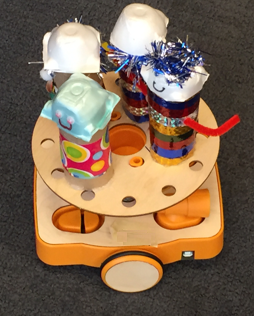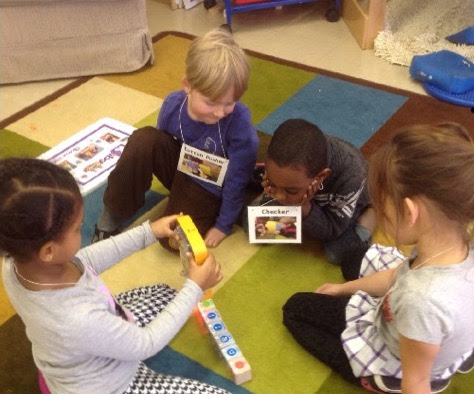Views from the Classroom: STREAM Education
KIBO has found a home in every kind of school and informal educational setting we can think of, including many schools where religious education is a core mission. Within religious education, educators have recently begun expanding the familiar acronyms STEM (Science, Technology, Engineering and Math) and STEAM (which adds Art) to talk about STREAM, adding the “R” to represent religion. For these early educators and their students, STREAM brings the hands-on, experiential, and creative learning of STEAM to the study of the historical, cultural, and spiritual dimensions of kids’ religious heritages. And many teachers have found that KIBO, with its emphasis on expression and individualization, is a perfect fit for STREAM teaching techniques.
 We’ve spoken with early educators whose students have turned their KIBOs into Noah’s Ark, complete with animal passengers, to explore and visualize this familiar Bible story. Other KIBOs have crossed the Red Sea out of Egypt, enacting the story of the Israelites journey and escape from Pharaoh’s army. And KIBOs have celebrated Purim with joyful costumes which reflect the individuality of the students who create them.
We’ve spoken with early educators whose students have turned their KIBOs into Noah’s Ark, complete with animal passengers, to explore and visualize this familiar Bible story. Other KIBOs have crossed the Red Sea out of Egypt, enacting the story of the Israelites journey and escape from Pharaoh’s army. And KIBOs have celebrated Purim with joyful costumes which reflect the individuality of the students who create them.
Dr. Amy Ryan, the Assistant Superintendent of Academics & Digital Learning for the Catholic Schools Office in the Archdiocese of Boston, has been helping Boston-area Catholic schools implement a robotics curriculum as part of the Archdiocese’s larger STREAM education initiatives. Kindergarteners at 11 local schools, including Blessed Sacrament school in Walpole, Sacred Heart School in Lynn, and St. Paul Elementary School in Hingham, explored coding and programming concepts with KIBO while working collaboratively on projects merging technology, creativity, and exploration. Ryan sees STREAM projects as a natural fit with the educational philosophy of the Archdiocese of Boston Catholic schools, which combine a spirit of inquiry with an understanding of values and faith.
 In the Edmonton Catholic School District in Canada, teachers devote a portion of each day to specific religious curriculum; and more broadly, they work to incorporate religious education into all subjects and aspects of school life. In this effort, early educators are guided by formal curricular outcomes — standards related to Catholic philosophy and values. Cory Roffey, a teacher at the St. Pius X Elementary School in Edmonton, Canada, developed a roles-based KIBO activity with the district’s grade one “Living in Solidarity” curricular guidance in mind.
In the Edmonton Catholic School District in Canada, teachers devote a portion of each day to specific religious curriculum; and more broadly, they work to incorporate religious education into all subjects and aspects of school life. In this effort, early educators are guided by formal curricular outcomes — standards related to Catholic philosophy and values. Cory Roffey, a teacher at the St. Pius X Elementary School in Edmonton, Canada, developed a roles-based KIBO activity with the district’s grade one “Living in Solidarity” curricular guidance in mind.
“As students work in groups to code with KIBO exploring content and curriculum across subject areas, they are also learning how to work and exist within a human community,” Roffey explained. Working in a collaborative model helps the students understand “that they are called by God to offer friendship and love to those in their class community as they think and create and code together with KIBO. Therefore, it is the communal aspect that KIBO offers that makes it a great tool to support elements of our Religious Education Program at St. Pius X School.” (You can read more about Roffey’s roles-based collaborative KIBO projects in our December 2015 newsletter.)
 For many, religious study includes an exploration of the cultural and historical dimensions of students’ religious heritage. At Yavneh Academy, a modern orthodox Yeshiva in Paramus NJ, includes the study of Judaism and it’s history and geography of the State of Israel. Chani Lichtiger, director of Educational Technology, told us that Yavneh’s Judaic studies teacher incorporates KIBO coding in her curriculum throughout the year. Lichtiger explained a representative unit: “As a culminating project, the students are divided into small groups. Each group is responsible to “dress” their KIBO for Yom Yerushalayim (Jerusalem Day). They students plan for their road trip from different locations in Israel to their specific gates of Jerusalem. A large visual map is placed in the center of the classroom floor, with roads leading to the gates. Each KIBO is then programmed to leave their specific location, for example, Tel Aviv or Haifa, and continues down the road through their respective gate. Each group has a special Israeli song which they sing as the KIBOs arrive. The excitement in the room is palpable and adds to the mood of this exciting day.”
For many, religious study includes an exploration of the cultural and historical dimensions of students’ religious heritage. At Yavneh Academy, a modern orthodox Yeshiva in Paramus NJ, includes the study of Judaism and it’s history and geography of the State of Israel. Chani Lichtiger, director of Educational Technology, told us that Yavneh’s Judaic studies teacher incorporates KIBO coding in her curriculum throughout the year. Lichtiger explained a representative unit: “As a culminating project, the students are divided into small groups. Each group is responsible to “dress” their KIBO for Yom Yerushalayim (Jerusalem Day). They students plan for their road trip from different locations in Israel to their specific gates of Jerusalem. A large visual map is placed in the center of the classroom floor, with roads leading to the gates. Each KIBO is then programmed to leave their specific location, for example, Tel Aviv or Haifa, and continues down the road through their respective gate. Each group has a special Israeli song which they sing as the KIBOs arrive. The excitement in the room is palpable and adds to the mood of this exciting day.”
Professor Marina Bers, our Chief Scientist and a professor at Tufts University, has conducted a great deal of research on using creative technology engagement to help students explore their communities, identities, and heritage; this has included exploration of STREAM concepts. Many of Professor Bers’ papers on these topics are available too!
We designed KIBO to introduce programming and coding concepts, but just as importantly we designed KIBO to be extended, embellished, decorated, and personalized, so that KIBO can participate in many different kinds of stories told by kids and early educators. KIBO’s expressiveness gives it the flexibility to support a wide range of curriculum, and we are very happy that these creative teachers have been so successful in incorporating KIBO into their STREAM education. Our new Expression Module, which gives KIBO the ability to carry signs, flags, or a whiteboard, extends this expressiveness even further. As always, we can’t wait to see what new projects teachers will come up with for KIBO.



















